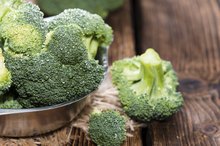Signs & Symptoms of Selenium Poisoning
Selenium is a mineral that's essential to the body in trace amounts, mainly for synthesizing enzymes, but it can be toxic in large amounts. According to the “Doctor's Complete Guide to Vitamins and Minerals,” the tolerable upper intake level of selenium is set at 400mcg daily, with 800mcg daily potentially causing toxicity and a dose of 5mg considered lethal for most people. Selenium poisoning has no known antidote, so recognition of the signs and symptoms is essential for survival.
Main Sources of Selenium
Selenium is used in some photographic devices, gun cleaning solutions, plastics, paints, anti-dandruff shampoos, vitamin and mineral supplements, fungicides and some types of glass. It's also used to manufacture drugs and as a nutritional feed supplement for livestock and poultry.
Exposure to Selenium
Minerals for Fingernails and Fine Hair
Learn More
In some regions of the U.S., especially the western states, the soil has naturally higher levels of selenium. This can build up in the plants and injure the livestock that feed on them. According to the Agency for Toxic Substances and Disease Registry, people who consume crops, vegetables or animal products in these regions could be exposed to too much selenium. Additionally, excessive supplementation of selenium is a growing cause of toxicity and poisoning, sometimes because selenium levels are given in micrograms and some people mistake it for milligrams -- a thousand-fold difference.
- In some regions of the U.S., especially the western states, the soil has naturally higher levels of selenium.
- According to the Agency for Toxic Substances and Disease Registry, people who consume crops, vegetables or animal products in these regions could be exposed to too much selenium.
Respiratory Symptoms
Respiratory symptoms of selenium poisoning include mucous membrane irritation, coughing, garlicky breath odor, bronchitis, bronchial pneumonia, reduced respiratory rate, and ultimately, pulmonary edema and death.
Gastrointestinal Symptoms
Zinc for Nail Growth
Learn More
Gastrointestinal symptoms of selenium poisoning include stomach upset, nausea, vomiting, diarrhea, a bitter metallic taste with burping and intestinal cramps, according to “The New Encyclopedia of Vitamins, Minerals, Supplements and Herbs.”
Hair, Nail, Teeth and Skin Changes
Common early symptoms of selenium toxicity and poisoning involve the hair and nail beds of the hands and feet. Excessive selenium causes brittle hair, hair loss, deformed nails, brittle nails, sloughing off of nails, tooth discoloration, tooth decay and mottled or discolored skin.
Neurological Signs
Neurological signs of selenium poisoning infer damage to nerves and brain tissue. They include fatigue, irritability, listlessness, reduced mental alertness, emotional instability, hand tremors, tingling or loss of sensation in the arms or legs, reduced blood pressure and ultimately, unconsciousness and death.
Related Articles
References
- “Doctor's Complete Guide to Vitamins and Minerals”; Mary Dan Eades and Philip Lief; 2002
- Agency for Toxic Substances and Disease Registry: Centers for Disease Control: Public Health Statement for Selenium
- “The New Encyclopedia of Vitamins, Minerals, Supplements, and Herbs”; Nicola Reavley; 1999
- Bleys J, Navas-Acien A, Stranges S et al. Serum selenium and serum lipids in US adults. Am J Clin Nutr 2008; 88: 416-423.
- Laclaustra M, Stranges S, Navas-Acien A et al. Selenium status and serum lipids in US adults: National Health and Nutrition Examination Survey (NHANES) 2003-2004. Atherosclerosis 2010; 210: 643-648.
- Rayman MP, Stranges, S, Griffin BA et a, Ann Int Med 2011; 154: 656-665.
- Rayman MP. Selenium and human health. Lancet 2012; 379: 1256-1268.
- Stranges S, Tabak AG, Guallar E, et al. Selenium status and blood lipids: the cardiovascular risk in young finns study. J Int Med 2011; 270: 469-477.
Writer Bio
Owen Bond began writing professionally in 1997. Bond wrote and published a monthly nutritional newsletter for six years while working in Brisbane, Australia as an accredited nutritionalist. Some of his articles were published in the "Brisbane Courier-Mail" newspaper. He received a Master of Science in nutrition from the University of Saskatchewan.









